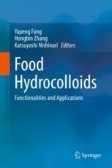Search
Search Results
-
Flavour Chemistry
After studying this chapter, you will be able to:
-
Flavour by design: food-grade lactic acid bacteria improve the volatile aroma spectrum of oat milk, sunflower seed milk, pea milk, and faba milk towards improved flavour and sensory perception
BackgroundThe global market of plant-based milk alternatives is continually growing. Flavour and taste have a key impact on consumers’ selection of...

-
Identification of antioxidant and flavour marker compounds in Kalosi-Enrekang Arabica brewed coffee processed using different postharvest treatment methods
This research aims to predict the presence of marker compounds that differentiate tubruk brew from coffee beans with different postharvest...

-
Effect of enzyme hydrolysis on the functionality, protein quality, and flavour profile of lentil and chickpea protein isolates
The overarching goal of this research was to investigate the effect of trypsin hydrolysis on the functional properties, protein quality, and flavour...

-
Flavour Stability of a Cold-Stored Unpasteurized Low-Alcohol Beer Produced by Saccharomycodes ludwigii
Low-alcohol beer (LAB) is a growing part of the brewing industry in terms of market volumes and consumer interest. Universities and research centres...

-
Synergy of 1-MCP and hypobaric treatments prevent fermented flavour and improve consumers’ acceptability of ‘Shughri’ pear
Development of fermented flavour during storage reduces acceptability of Shughri pear. Therefore, the current study was designed to investigate the...

-
Flavour Delivery
Flavourings are usually complex blends of solid or liquid compounds that need to be turned into a format useful to the food or beverage manufacturer....
-
Production of nutty-like flavour from soybean protein isolate hydrolysate pretreated or assisted by microwave irradiation: impact of encapsulation on nutty flavour quality
The aim of this study was to prepare a nutty-like flavour from enzymatic hydrolysates of soybean protein isolate pretreated or assisted by microwave...

-
Candida rugosa Lipase Immobilization on Fe3O4 Coated Carboxyl Functionalised Multiwalled Carbon Nanotubes for Production of Food Flavour Esters
The objective of the study was carboxyl functionalization of Fe 3 O 4 coated multiwalled carbon nanotubes (MWCNTs),...
-
Impact of processing on important cocoa off-flavour compounds
The compounds responsible for smoky and mouldy–musty off-flavours in fermented cocoa have recently been elucidated; however, their behaviour during...

-
Development and evaluation of an automated solvent-assisted flavour evaporation (aSAFE)
Artefact-avoiding isolation of the volatiles from foods is a crucial step before analysis of odour-active compounds by gas chromatography (GC). In...

-
Flavour Chemistry
After studying this chapter, you will be able to:
-
Combined effects of tangerine oil vapour mixed with banana flavour to enhance the quality and flavour of ‘Hom Thong’ bananas and evaluating consumer acceptance and responses using electroencephalography (EEG)
The objectives of this study were to investigate the effect of tangerine oil (TO) at 25, 50 and 75 µL mixed with banana flavour (BF) at 25, 50 and...

-
Improved recovery of higher boiling point volatiles during solvent-assisted flavour evaporation
Previously published data show that high levels of fat (50%) affect the yield of volatile compounds during solvent-assisted flavour evaporation...

-
Profiling of volatile substances by direct thermal desorption gas chromatography high-resolution mass spectrometry for flagging a characterising flavour in cigarette tobacco
This paper describes an analytical method that supports the implementation of articles 9 and 10 of the WHO Framework Convention on Tobacco Control...

-
Policy, toxicology and physicochemical considerations on the inhalation of high concentrations of food flavour
Food flavour ingredients are required by law to obtain prior approval from regulatory bodies, such as the U.S. Food and Drug Administration (FDA) or...

-
Proteomic approach to identify the differentially abundant proteins during flavour development in tuberous roots of Decalepis hamiltonii Wight & Arn.
2-Hydroxy-4-Methoxy Benzaldehyde (2H4MB) is a structural isomer of vanillin produced in the tuberous roots of D. hamiltonii . Both vanillin and 2H4MB...

-
The impact of different adsorbents on flavour characteristics of a lentil protein isolate
In this study, the effect of different adsorbents on the reduction of off-flavours within a lentil protein isolate (LPI) was examined by isolating...

-
Volatile profile and sensory properties of gluten-free bread with yellow pea flour and sourdough
Legume flours can nutritionally enrich gluten-free bread but can also negatively affect its flavour. Although sourdough fermentation can improve...

-
Genome-based selection and application of food-grade microbes for chickpea milk fermentation towards increased l-lysine content, elimination of indigestible sugars, and improved flavour
BackgroundPlant-based milk alternatives are more popular than ever, and chickpea-based milks are among the most commercially relevant products....

